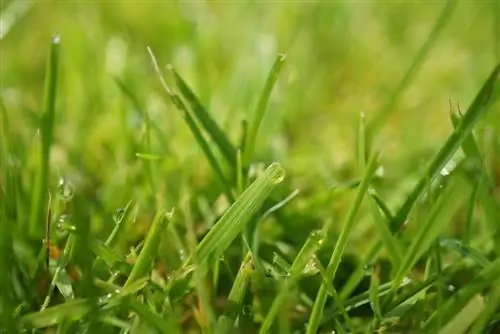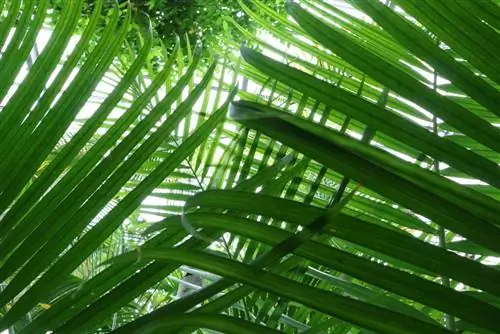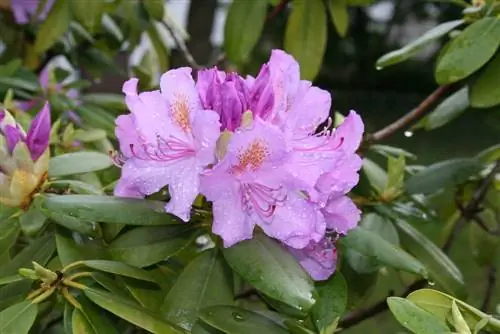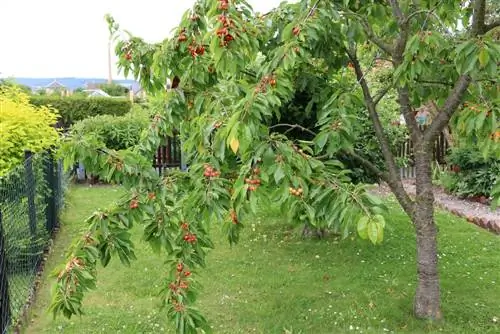- Author admin [email protected].
- Public 2023-12-17 03:39.
- Last modified 2025-01-24 12:45.
Fir fertilizer is the general term for the fertilizer that is most suitable for coniferous plants. It is completely clear that it is not only there for fir trees, but also for spruce, thuja, pine, juniper and other conifers. Needle browning is particularly feared in coniferous trees, which fir fertilizer with magnesium prevents.
A fertilizer for all conifers
Conifers need a fertilizer that is different from that for other trees. They are often not adequately supplied with a simple NPK fertilizer and can develop deficiency symptoms - including the dreaded needle tan, which can be prevented with a fertilizer containing magnesium. Most coniferous plants do not differ so much in their nutrient requirements that they would require an even more specific fertilizer - fir fertilizer does it for everyone.
Ingredients
Fir fertilizer contains more than the usual components sodium, phosphate and potassium. It consists partly of organic material, but also contains iron, magnesium and sulfur. The proportions vary depending on the manufacturer. In contrast to other types of fertilizers, fir fertilizer can be used all year round and does not differ in composition between different seasons. Since the coniferous plants are usually found outdoors and have the opportunity to expand their root network as needed, they can supplement missing nutrients independently. Plants that are kept in vats or indoors cannot do this - a special fertilizer whose composition takes the seasons and growth phases into account is more suitable for them.
Application and dosage
Firs and spruces are fertilized from February to August, these are the months in which the trees grow. From August onwards they prepare for hibernation and no longer need fertilizer until they sprout again next spring. 70 to 140 g of fertilizer per square meter is recommended per dose, depending on the size of the tree. Depending on the weather and absorption capacity, the fertilizer is available for between one week and ten weeks, depending on the soil permeability, soil quality and size of the tree. As a rule, new fertilizer is added every six to eight weeks. One tablespoon holds about 20 g of solid fertilizer, so the amount per dose is three or more tablespoons full of fertilizer.
The fertilizer is spread on the ground around the tree and incorporated flatly but evenly. If a tree has been newly planted or relocated, fertilizer is also applied, and in some cases a little more abundantly. There can be up to 180 g of fertilizer per square meter. It is worth at least roughly adhering to the manufacturer's instructions on the amount of fertilizer required, because despite contrary opinions, you can also over-fertilize fir and spruce trees.
Epsom s alt instead of fir fertilizer
Of course, trees can grow outdoors without fertilizer - there is no fertilization in the forest either. However, fir fertilizer contains a mixture of nutrients that not only ensures green needles, but is also rich enough in nitrogen to make the plants grow very strongly - faster than they would in nature. If firs and spruces only grow slowly on your own garden plot, then it is advisable to use less fir fertilizer. Epsom s alt ensures beautiful green needles and a vital appearance. Epsom s alt is a highly concentrated magnesium sulfate fertilizer that is actually only intended as an additional fertilizer for brown needles. However, if used carefully and to curb growth, the s alt can also serve as a sole fertilizer. Epsom s alt is available as a liquid mixture and as a dry fertilizer. If Epsom s alt is applied dry, it should not just be worked flat into the soil around the plants. The plants also need to be watered generously so that the fertilizer can dissolve in the water and be absorbed by the roots. It is also important to pay attention to the manufacturer's instructions when it comes to Epsom s alt: the fertilizer must not be overdosed.
If it's not the fertilizer
Coniferous trees not only get brown needles when the soil is too nutrient-poor, but also for other reasons. Before fertilizing abundantly and excessively, you should carry out a soil analysis - this applies to planned fertilization with fir fertilizer as well as to Epsom s alt. Strong soil compaction also causes the characteristic discoloration of the needles. A location that is too wet can also be the reason for brown needles. In such a case, additional fertilizer would not help the tree but would actually make the situation worse. If you only fertilize with Epsom s alt, this can also cause the needles to turn brown because a high magnesium density in the soil prevents the absorption of potassium. It may therefore make sense to use fir or conifer fertilizer instead of Epsom s alt.
Prolonged drought and too much road s alt in winter, which gets into the garden via meltwater and rainwater, can also cause brown needles in coniferous plants. Aside from that, pests like Sitka spruce louse and pine mealybug are also known to turn the needles of infected trees brown. Fertilizing does not help in these cases.
Tips for speed readers
- Firs, spruces, thuja and other conifers are generally better supplied with a fir fertilizer than with a pure NPK fertilizer.
- In addition to nitrogen, phosphate and potassium, fir fertilizer also contains sulfur, iron and magnesium.
- Magnesium and sulfur prevent needle tan.
- Fir fertilizers containing nitrogen have an accelerated effect on the growth of coniferous trees. If you want the trees to grow more naturally (i.e. more slowly), Epsom s alt is recommended.
- Epsom s alt is an additional fertilizer that essentially consists of magnesium and sulfate. The mixture makes coniferous trees look fresher and greener.
- Fertilization is carried out between February and August: During these months, trees are in the growth phase and need additional nutrients.
- When fertilizing, you should always follow the manufacturer's instructions: over-fertilized trees suffer from he alth problems.
- Fir fertilizer and Epsom s alt are distributed in the soil around the tree (the amount depends on the size of the tree and square meters of soil available) and worked in flatly and evenly.
- If fertilized with solid fertilizer, water should always be abundant afterwards.
- Fir trees need loose soil and a location that is not too moist - brown needles can also be due to soil compaction or waterlogging.
- Coniferous trees have shallow roots, dryness can be a reason for brown needles. Other reasons that have nothing to do with fertilization include road s alt and pests.
What you should know about fir fertilizer in brief
Coniferous trees such as fir should not be fertilized from autumn to spring, as they are then not in the growth phase. There is no harm in adding water during this time, but it is not absolutely necessary. Fertilization only takes place from February/March. Fir fertilizer or Epsom s alt can be used here. However, you should never fertilize before the plant has been watered for the first time! You can only assume that the fir fertilizer is effective enough if you have already watered it once or if the ground is still moist due to the rainfall.
- Fir fertilizer uses various nutrients such as nitrogen, which the plants are then supplied with.
- Magnesium is also present in large quantities in fir fertilizer. On the one hand, this combats the magnesium deficiency in the soil.
- On the other hand, the magnesium can counteract a brownish discoloration of the needles, which occurs particularly in spring due to the change from little light and sun to a lot of light and sunshine.
- With the right fir fertilizer and the use of Epsom s alt, it is possible to prevent these discolorations or to treat them completely.
- With Epsom s alt, for example, a dosage of 100 to 200 milligrams per square meter makes sense for the healing treatment.
- For preventative treatment, you should choose a dosage of 50 to 200 milligrams.
- The best dosage depends not only on the plants that you want to fertilize with fir fertilizer, but also on the fir fertilizer used itself.
- Here you should also pay attention to the price, which should not be more than around two to three euros per pack.






